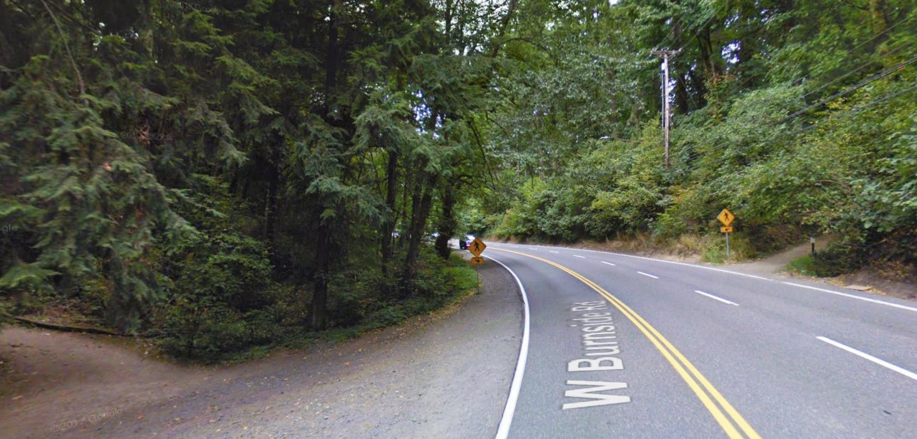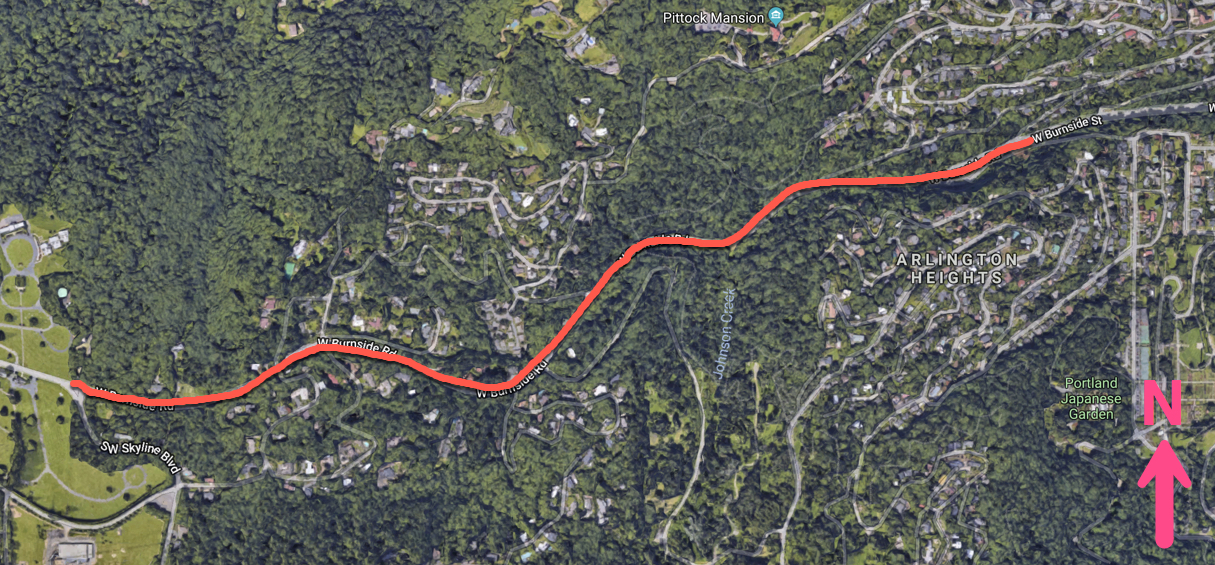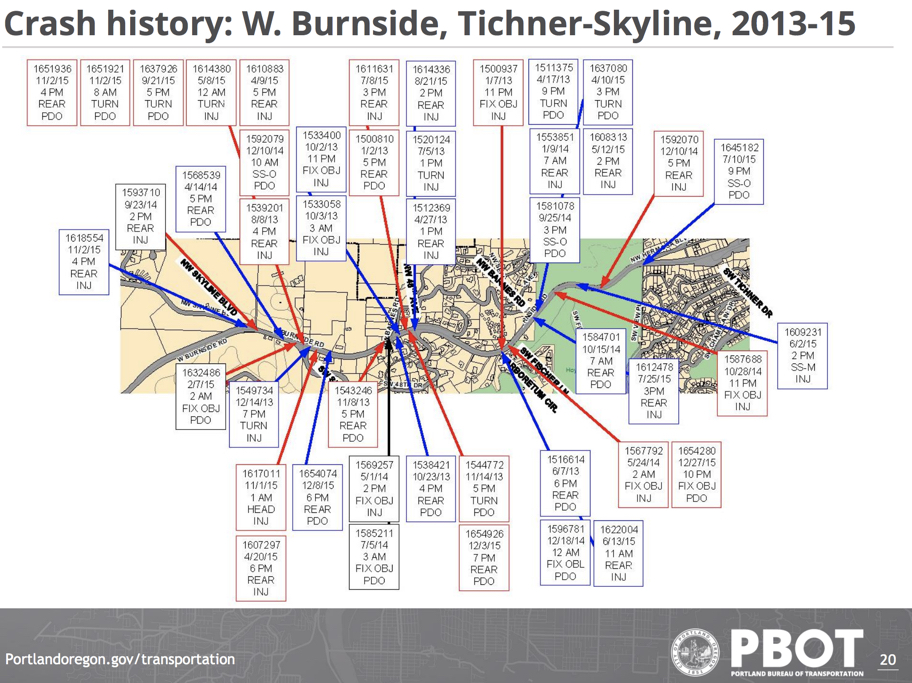
The City of Portland wants to make a 1.5 mile section of Burnside that runs through a wooded area of the West Hills more human-friendly. But the State of Oregon has thrown a wrench in the works.
Between Skyline Boulevard and Tichner Road, the curvy and relatively narrow three-lane cross-section tears right across the Wildwood Trail, Portland’s marquee hiking destination. The trail crosses Burnside in a curve with poor sightlines and Oregon Department of Transportation data shows a majority of people go over the 40 mph speed limit. This section of road also has such a dubious crash history — 45 of them between 2013 and 2015, 35 of which resulted in people being injured — that the Portland Police Bureau has flagged it as a concern.

“It is difficult to support the City’s request. Without dramatic enforcement, this percentage of violators would increase significantly if the speed was lowered.”
— Mike Kimlinger, ODOT Speed Zone Review Panel Secretary
In fall of last year, the Portland Bureau of Transportation filed a formal request to lower the speed limit from 40 to 35 mph. In response, ODOT launched a speed investigation study in August. A month later they denied the City’s request. PBOT then appealed the decision to the State’s Speed Zone Review Panel. This panel meets quarterly and is made up of representatives from the Oregon Transportation Safety Committee, the Oregon State Police, the Association of Oregon Counties, the League of Oregon Cities and ODOT. The meeting to hear the appeal was held on March 21st in Salem.
According to a copy of the meeting minutes we obtained, ODOT opened things up with an explanation of the 85th percentile rule, their current method for setting speeds. The 85th percentile speed is the speed at or below which 85 percent of motor vehicle users travel. Agencies that follow this rule believe that’s what drivers feel is “reasonable and safe,” and therefore limits should be set as close to it as possible.
The problem is, that rule is outdated and might actually make roads more dangerous. PBOT doesn’t believe in it. “The 85th percentile method is not supported by evidence and is not part of PBOT practice,” states PBOT’s website. And as of last summer even the National Transportation Safety Board warned against it.
But ODOT still uses it. Before hearing PBOT’s appeal, the five members of the Speed Zone Review Panel heard an ODOT engineer explain how using the 85th percentile is the state’s primary tool that yields the best results. The agency does acknowledge that alternative methods are currently being discussed but, “For now,” the ODOT panel secretary states in the minutes, “the current method is what we must rely on.”
It’s worth noting that, as an agency, ODOT does not believe lower speed limits improves safety or reduces crashes. In a FAQ document posted on their website, they write, “Drivers are much more influenced by the roadway conditions and their perceptions of the need to slow down.” Going further, ODOT believes that if posted speeds are too low it could actually make conditions more dangerous due to the potential for a higher variance in speeds between drivers.
The panel then heard that the section of Burnside in question has an 85th percentile speed of 46, meaning 85 percent of drivers go at or below 46 mph. ODOT’s investigation also found that 58 percent of drivers exceed the posted limit of 40 mph and 74 percent travel between 37 and 46 mph.
These findings led the ODOT engineer to tell the panel that, “It is difficult to support the City’s request.” “Without dramatic enforcement, this percentage of violators would increase significantly if the speed was lowered,” the minutes state. “The general experience is lowering the speed limit only marginally lowers the speed of vehicles.”
Advertisement

Then PBOT traffic engineer Carl Snyder presented the city’s case. He told the panel that Burnside has nearly four times the rate of “street departure” crashes versus the citywide average and that high speeds were a factor in 47 percent of all fatal collisions between 2004 and 2013. Snyder also pointed out that lowering speed limits is one of three actions called out in PBOT’s Vision Zero Action Plan, adopted by City Council in 2016.
“His reservation against lowering it would make too many drivers law breakers given the existing speeds observed.”
— from ODOT Speed Zone Review Panel meeting minutes (March 21st, 2018)
PPB Traffic Division Captain Michael Crebs then testified in support of PBOT’s request. He said a lower speed limit is needed on Burnside because the curves and geometry of the road don’t leave much room for error.
The panel then began deliberations. Here’s how they responded:
Dorothy Upton said she understood the City’s desire to lower speeds but she doesn’t see lowering the speed as being effective.
Stacy Shetler said he felt the same.
Patrick Huskey said he supported lowering the speed to 35 MPH because retaining the 40 MPH would not address the crash history.
Victor Hoffer said he supported lowering the speed to 35 MPH but believes it should be more consistently applied on the road outside the investigated section. He also thought the proposed pedestrian bridge should be redesigned to be out of the line of sight so it’s not a crash hazard.
Brian Barnett said he had reservations regarding retaining existing speeds and against lowering the speed. His reservation against lowering it would make too many drivers law breakers given the existing speeds observed. It would not be in the spirit of uniformity to do so by itself. He thought the [infrastructure] improvements Portland is working on is a good first step for lowering speeds and increasing safety. But he doesn’t think changing the speed by five MPH would make gaps any bigger to increase safety in more congested hours. He drove the route two or three times in the morning and noted most of the signs are obscured by vegetation. He said he didn’t think Portland did enough due diligence in providing data to support their request.
Ultimately the request was denied by a vote of 2-3.
The decision might also impact the planned footbridge over Burnside at the Wildwood Trail. PBOT has recently learned that the current design of the bridge assumed a 35 mph speed limit. Because of sightlines and potential safety hazards, federal guidelines could trigger a redesign if Burnside remains at a 40 mph speed limit.
This is a frustrating setback for the City of Portland.
“The 85th percentile is an old way of setting speeds… These are the type of things we have to battle.”
— Michael Crebs, PPB Traffic Division Captain
PBOT works hard to reduce speed limits. From pushing legislation that led to our 20 mph residential speed limit to using an arcane emergency statute and high-tech cameras to catch speeders, their work has made a difference. One front of their war on speed that doesn’t get as much attention is the case-by-case requests they make to the Oregon Department of Transportation to reduce speed limits on a specific section of road.
In 2017, PBOT lowered speed limits in 33 areas. They’re so proud of it they even keep a running tally.
In case you’re wondering why ODOT is involved in City streets, that’s because the State of Oregon controls all speed limits, whether or not they have jurisdiction over the roadway itself. If a local government wants to change speeds, they must go through a request process (which was thankfully simplified in 2016).
ODOT’s Burnside decision flies in the face of the direction PBOT and the Portland Police Bureau want to take our streets.
On May 9th, two months after the denial, Capt. Crebs told a crowd of advocates at an event hosted by The Street Trust that, “The 85th percentile is an old way of setting speeds.” Crebs was clearly frustrated by ODOT’s decision, saying, “These are the type of things we have to battle,” and, “I’d really love to have the City of Portland have the ability to set its own speeds.”
While ODOT adheres to an outdated speed policy that favors fast driving, the agency is looking at a record number of traffic deaths in 2018. So far this year 179 people have died on Oregon roads. That’s nearly 20 percent more fatalities than this time last year.
We can only hope there won’t be any more victims on Burnside.
On the bright side, ODOT has programmed $170,000 for a safety project on West Burnside that will include curve warnings, reflective pavement markers on the center and edge lines, and a speed warning system east of Barnes Road. That project should be completed by 2021. And thankfully, PBOT hasn’t given up. They plan to pursue another speed limit reduction request once the street is eligible again in 2020.
In related news, Kate Walker’s campaign to lower speed limits on SE Stark in the Montavilla neighborhood was successful!
— Jonathan Maus: (503) 706-8804, @jonathan_maus on Twitter and jonathan@bikeportland.org
Never miss a story. Sign-up for the daily BP Headlines email.
BikePortland needs your support.

